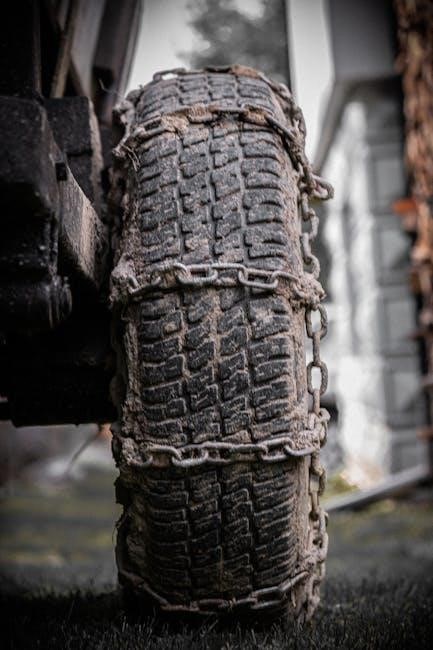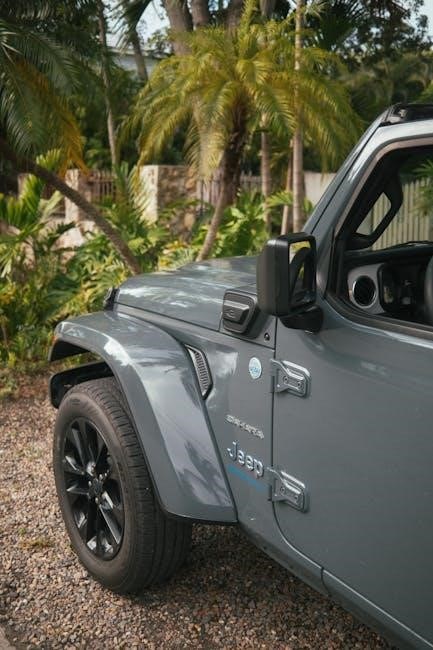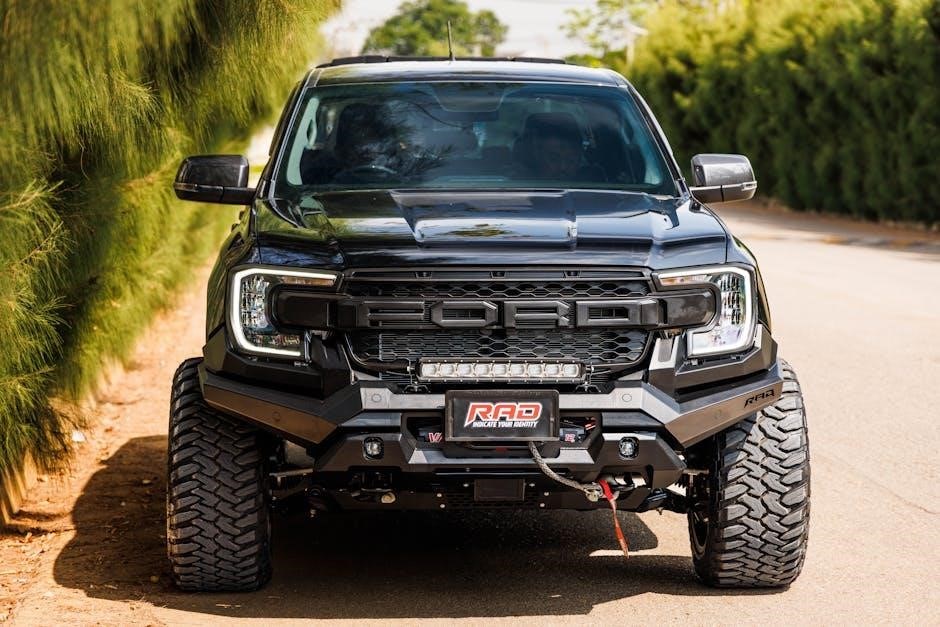Off-road tires are specially designed for challenging terrains, offering enhanced traction and durability. Their size and tread pattern significantly impact performance, safety, and vehicle stability, making proper selection crucial.
Why Tire Size Matters for Off-Road Performance
Tire size is critical for off-road performance as it directly impacts ground clearance, traction, and vehicle stability. Larger tires can improve clearance for navigating obstacles like rocks or deep mud, while smaller tires may compromise performance. The tread pattern and width also affect grip on various surfaces, such as sand, gravel, or snow. Proper sizing ensures optimal load capacity and avoids fitment issues, which are essential for safety and control in challenging terrains. Matching the tire size to the vehicle’s make and modifications ensures balanced performance and durability.
Overview of Key Factors in Choosing Off-Road Tires
When selecting off-road tires, several factors are crucial. Tire size must match the vehicle’s specifications to ensure proper fitment and performance. Tread pattern and depth are essential for traction on different terrains, such as mud, rock, or sand. Load capacity and speed ratings must align with the vehicle’s weight and intended use. Additionally, sidewall strength and material durability impact resistance to punctures and wear. Vehicle modifications, like lift kits, also influence tire choice. Balancing these factors ensures optimal performance, safety, and longevity of the tires in off-road conditions.

Understanding Off-Road Tire Size Codes
Off-road tire size codes on sidewalls provide essential info about width, diameter, and load capacity, helping users select tires suited for their vehicle and terrain needs.
Metric Tire Sizes Explained
Metric tire sizes are coded with numbers like 315/70R17, where 315 represents the width in millimeters, 70 is the aspect ratio, and 17 is the rim diameter. The sidewall also includes load and speed ratings, such as Q or S, indicating maximum weight capacity and speed limits. Understanding these codes ensures proper fitment and performance for off-road vehicles, balancing traction, durability, and handling on diverse terrains. Accurate sizing is crucial for safety and optimal off-road capability, making metric codes a vital reference for enthusiasts and professionals alike.
Flotation Tire Sizes and Their Meaning
Flotation tire sizes, like 33×12.5R17, are designed for soft terrains such as mud, sand, or snow. The first number (33) is the diameter, the second (12.5) is the width, and the third (17) is the rim size. These tires provide increased surface contact, reducing pressure and enhancing traction. Their larger footprint improves stability and floatation, making them ideal for heavy-duty off-road use. Understanding flotation sizes ensures proper fitment and optimal performance in challenging environments, balancing durability and grip for adventurous driving conditions.
Alpha Numeric Tire Sizes and Their Applications
Alpha numeric tire sizes, like P235/70R16, combine letters and numbers to denote specific tire types and dimensions. The letter represents the tire class (e.g., P for passenger), while the numbers indicate width, aspect ratio, and rim size. These sizes are commonly used for light trucks and SUVs, balancing on-road comfort with off-road capability. Their design offers versatility for various terrains, making them ideal for vehicles needing both daily driving practicality and moderate off-road performance, ensuring proper fitment and functionality across diverse driving conditions.

How to Choose the Right Off-Road Tire Size
Selecting the right off-road tire size involves matching your vehicle’s specifications, considering terrain demands, and ensuring proper load capacity. Always account for modifications and wheel size to ensure optimal fitment and performance.
Matching Tire Size to Vehicle Type and Make
Ensuring your off-road tires match your vehicle’s type and make is critical for safety and performance. Always refer to your vehicle’s owner’s manual or the tire information placard for specifications. The correct tire size guarantees proper fitment, load capacity, and speed rating. Using mismatched tires can lead to poor handling, reduced traction, and increased risk of failure. Consider your vehicle’s intended use, whether for heavy-duty off-roading or casual adventures, and select tires that align with its capabilities and modifications. Proper sizing enhances stability, control, and overall off-road performance.
Considering Terrain and Tire Tread Patterns
When choosing off-road tires, terrain and tread patterns are crucial. Muddy terrains require aggressive tread with deep grooves for traction, while rocky surfaces benefit from durable, puncture-resistant designs. Sandy terrains may need specialized tread for flotation. The right tread pattern enhances grip, stability, and control, ensuring optimal performance and safety in various off-road conditions. Always match the tread design to your primary off-road environment for the best results.
Load Capacity and Speed Ratings for Off-Road Tires
Load capacity and speed ratings are critical for off-road tires, ensuring they can handle the vehicle’s weight and operate safely at intended speeds. The load capacity, often indicated by a numeric value on the sidewall, must match or exceed the vehicle’s gross weight. Speed ratings, denoted by letters, specify the maximum speed the tire can handle. Properly matching these ratings to your vehicle and driving conditions ensures optimal performance, safety, and durability, preventing potential damage or failure during off-road adventures.
Factors Influencing Off-Road Tire Size Selection
Vehicle modifications, wheel size, and clearance are key factors in selecting off-road tire sizes. Proper fitment ensures performance, safety, and avoids potential damage or rubbing issues.
Vehicle Modifications and Lift Kits
Vehicle modifications, such as lift kits, significantly impact off-road tire size selection. Lift kits increase ground clearance, allowing larger tires for better traction and obstacle clearance. However, improper tire sizing can lead to reduced performance, uneven wear, or rubbing against fenders. When installing lift kits, consider factors like wheel spacers or adapters to maintain proper fitment. Additionally, modified suspension systems may require specific tire load ratings to ensure safety and stability. Always ensure compatibility between tires and vehicle modifications for optimal off-road performance and reliability.
Wheel Size and Offset Considerations
Wheel size and offset play a critical role in off-road tire size selection. Larger wheels, such as 20-inch options, can improve ground clearance and approach angles, but may reduce sidewall flexibility. Offset measurements ensure proper tire positioning within the wheel wells, preventing rubbing and ensuring stability. Incorrect offsets can lead to poor fitment and compromised handling. Always verify compatibility with your vehicle’s specifications and suspension modifications. Proper alignment ensures optimal performance, safety, and prevents uneven tire wear.
Clearance and Fitment Issues
Clearance and fitment are essential considerations for off-road tires. Proper tire width and rim width ensure adequate clearance to avoid rubbing against suspension or frame components. Incorrect tire size can lead to poor fitment, causing damage or handling issues. Always verify frame and fork clearance, especially with wider tires or modified vehicles. Lift kits and suspension upgrades may require adjustments to maintain proper fitment; Ensure tires are compatible with your vehicle’s specifications to avoid complications and optimize off-road performance. Proper fitment ensures safety, stability, and maximum traction on challenging terrains.
Maintenance and Care for Off-Road Tires
Regular maintenance ensures off-road tires perform optimally. Check tire pressure for off-road conditions, monitor tread wear, and clean sidewalls to prevent damage. Inspect for punctures and store tires properly when not in use to extend their lifespan and maintain performance.

Proper Tire Pressure for Off-Road Conditions
Maintaining the correct tire pressure is essential for off-road performance. Lower pressures improve traction on soft surfaces like sand or mud, while higher pressures are better for rocky terrain to prevent damage. Always consult your vehicle’s owner’s manual for recommended pressures and adjust based on the specific terrain. Use a reliable tire pressure gauge to ensure accuracy. Proper inflation enhances safety, reduces wear, and optimizes handling in challenging conditions. Under-inflation can lead to overheating and damage, while over-inflation reduces traction and control.
Monitoring Tire Wear and Tread Depth
Regularly inspecting tire wear and tread depth is vital for off-road performance and safety. Use a tread depth gauge to measure wear, ensuring it meets minimum safety standards. Look for uneven wear patterns, which may indicate misalignment or improper inflation. Check for signs of damage, such as cuts, cracks, or punctures, and replace tires as needed. Deep treads provide better traction, but excessively worn tires can compromise grip and increase the risk of failure. Monitor wear after challenging terrain use and adjust driving habits to extend tire life.
Cleaning and Protecting Sidewalls
Cleaning and protecting sidewalls is essential for maintaining tire durability and appearance. Use mild soap and water to remove dirt and grime, avoiding harsh chemicals that can damage rubber. Regular cleaning prevents cracks and fading. Apply UV protectants to shield sidewalls from sun damage. Avoid abrasive scrubbers to prevent surface wear. Dry thoroughly after cleaning to prevent cracks. Inspect sidewalls regularly for signs of damage or wear. Proper care extends tire life and ensures optimal performance on and off the road.
Future Trends in Off-Road Tire Technology
Future off-road tires will feature innovative materials like graphene for strength, smart tires with integrated sensors for real-time monitoring, and eco-friendly options made from sustainable rubber compounds.
Advancements in Tire Materials and Durability
Recent advancements in tire materials focus on enhancing strength and longevity. Graphene-infused compounds are being explored for superior durability, while reinforced sidewall plies improve puncture resistance. Eco-friendly materials, such as recycled rubber, are gaining traction, reducing environmental impact without compromising performance. These innovations ensure off-road tires can withstand harsh terrains and extreme conditions, offering better traction and extended lifespan. Sustainable practices are also being integrated into manufacturing, aligning with global efforts to reduce waste and promote greener technologies in the automotive industry.
Smart Tires and Integrated Vehicle Systems
Smart tires are revolutionizing off-road performance with integrated sensors that monitor real-time data. These systems adjust tire pressure, temperature, and tread wear, optimizing traction and stability. Advanced vehicle integration enables smart tires to communicate with onboard systems, enhancing safety and efficiency. Future innovations may include predictive maintenance alerts and energy-efficient designs, ensuring seamless adaptation to varying terrains and conditions, while maintaining optimal vehicle performance and driver control.
Eco-Friendly and Sustainable Tire Options
Eco-friendly tires are gaining traction as manufacturers focus on sustainability. Made from recycled materials, these tires reduce environmental impact while maintaining performance. Innovations include energy-efficient designs and biodegradable components, offering a greener alternative for off-road enthusiasts. Sustainable tires aim to minimize resource consumption and lower carbon footprints, appealing to environmentally conscious drivers. As demand grows, the industry is expected to expand eco-friendly options, ensuring off-road adventures remain thrilling while promoting a healthier planet.
Selecting the right off-road tires involves understanding size, tread, and vehicle specifics. Proper maintenance ensures durability and performance, while eco-friendly options promote sustainability for future adventures.
Final Tips for Selecting and Maintaining Off-Road Tires
Always match tires to your vehicle’s make, model, and terrain demands for optimal performance. Refer to your owner’s manual for size recommendations. Check load ratings to ensure tires can handle your vehicle’s weight and cargo. Regularly inspect tread depth and sidewalls for damage. Maintain proper tire pressure for off-road conditions to improve traction and reduce wear. Clean sidewalls to prevent cracking and extend lifespan. Consider upgrading wheels for better compatibility and clearance. Finally, consult professionals if unsure, and prioritize routine inspections for safety and durability.
Resources for Further Reading and Research
For deeper insights, explore guides from reputable tire manufacturers like Goodyear and Falken, offering detailed tire size calculators and fitment charts. Visit forums and communities dedicated to off-roading for real-world experiences and advice. Check specialized automotive websites such as Tire Rack, which provide comprehensive reviews and technical specifications. Utilize library databases for academic articles on tire technology and safety standards. Additionally, refer to your vehicle’s owner’s manual for specific recommendations tailored to your make and model. These resources ensure informed decision-making for your off-road tire needs.
